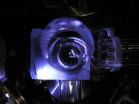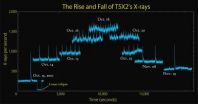(Press-News.org) The faster a clock ticks, the more precise it can be. Due to the fact that lightwaves vibrate faster than microwaves, optical clocks can be more precise than the caesium atomic clocks which presently determine time. The Physikalisch-Technische Bundesanstalt (PTB) is even working on several of such optical clocks simultaneously. The model with one single ytterbium ion caught in an ion trap is now experiencing another increase in accuracy. At PTB, scientists have succeeded in exciting a quantum-mechanically strongly "forbidden" transition of this ion and – in particular – in measuring it with extreme accuracy. The optical clock based on it is exact to 17 digits after the decimal point. The results are published in the current edition of the scientific journal Physical Review Letters.
Optical transitions are the modern counterpart of the pendulum of a mechanical clock. In atomic clocks, the "pendulum" is the radiation which excites the transition between two atomic states of different energy. In the case of caesium atomic clocks, it lies in the microwave range, in the case of optical clocks in the range of laser light so that their "pendulum" oscillates with higher velocity and optical clocks are – consequently – regarded as the atomic clocks of the future.
In the experiment performed at PTB, the scientists devoted themselves to a special forbidden transition. In quantum mechanics, "forbidden" means that the jump between the two energy states of the atoms is almost impossible due to the conservation of symmetry and angular momentum. The excited state can then be very persistent: In the case investigated here, the lifetime of the so-called F-state in the ytterbium ion Yb+ amounts to approx. 6 years. Due to this long lifetime, an extremely narrow resonance – whose linewidth only depends on the quality of the laser used – can be observed during the laser excitation of this state. A narrow resonance line is an important prerequisite for an exact optical clock. At the British National Physical Laboratory (NPL), the sister institute of PTB, the laser excitation of this Yb+-F state from the ground state was achieved for the first time in 1997. As the transition is, however, strongly forbidden, a relatively high laser intensity is required for its excitation. This disturbs the electron structure of the ion as a whole and leads to a shift of the resonance frequency so that an atomic clock based on it would exhibit a rate depending on the laser intensity.
At PTB it has now been possible to show that alternating excitation of the ion with two different laser intensities allows the unperturbed resonance frequency to be determined with high accuracy. Due to this, it has become possible to investigate other frequency shifts often occurring in atomic clocks – e.g. by electric fields or the thermal radiation of the environment. It has turned out that these are unexpectedly small in the case of the Yb+-F state, which can be attributed to the special electronic structure of the state. This is a decisive advantage for the further development of this atomic clock. In the experiments at PTB, the relative uncertainty of the Yb+ frequency was determined with 7 • 10-17. This corresponds to an uncertainty of the atomic clock of only approx. 30 seconds over the age of the universe.
Both groups at NPL and PTB have measured the frequency of the Yb+ transition with their caesium clocks and the results agree within the scope of the uncertainties (1 • 10-15 and 8 • 10-16) which are mainly determined by the caesium clocks. In a research project recently approved within the scope of the European Metrology Research Programme, the two institutes will in future cooperate with other European partners even more intensively in the development of this optical clock. In the case of the Yb+ ion, it is of particular interest that it has two transitions which are suitable for optical clocks: Less strongly forbidden, but also very precise, the excitation of the D-level can be used at a wavelength of 436 nm. This opens up the possibility of investigating the accuracy of the optical clock by frequency comparisons of the two transitions in one ion, without having to refer to a caesium clock.
INFORMATION:
Scientific publications
PTB experiment:
N. Huntemann et al.: High-accuracy optical clock based on the octupole transition in 171Yb+. Phys. Rev. Lett. 108,090801 (2012)
NPL experiment:
S. A. King et al.: Absolute frequency measurement of the 2S1/2 – 2F7/2 electric octupole transition in a single ion of 171Yb+ with 10-15 fractional uncertainty. New J. Phys. 14, 013045 (2012)
New 'pendulum' for the ytterbium clock
A transition which can only be excited with difficulty in the ytterbium ion allows an extremely high accuracy
2012-03-12
ELSE PRESS RELEASES FROM THIS DATE:
Iridescent, feathered dinosaur: New evidence that feathers evolved to attract mates
2012-03-12
The detailed feather pattern and color of Microraptor--a pigeon-sized, four-winged dinosaur that lived about 120 million years ago--had a glossy iridescent sheen.
Its tail was narrow and adorned with a pair of streamer feathers, suggesting the importance of display in the early evolution of feathers, say scientists reporting the findings in this week's issue of the journal Science.
By comparing the patterns of pigment-containing organelles from a Microraptor fossil to those in modern birds, the scientists determined that the dinosaur's plumage was iridescent with a ...
NOHO Dental Group Now Offers Several Special Promotions for New and Existing Patients
2012-03-12
NOHO Dental Group and Dr. Afar, North Hollywood dentist, are offering a variety of specials for new and existing patients. For a short time, patients can receive discounts on a wide number of dental procedures, allowing both new patients and those who have been with the NOHO Dental Group for years to save money and try new dental services.
These specials include a wide variety of services, such as a $49 dental exam with x-rays for new patients. For patients who need preventative care like dental cleanings, this special allows new patients to try out the services of Dr. ...
NIH study links childhood cancer to developmental delays in milestones
2012-03-12
Infants and toddlers who have been treated for cancer tend to reach certain developmental milestones later than do their healthy peers, say researchers at the National Institutes of Health and in Italy.
The findings show that delays may occur early in the course of treatment and suggest that young children with cancer might benefit from such early interventions as physical or language therapy.
Compared to children who had not had cancer, children treated for cancer before age 4 progressed more slowly in vocabulary, cognitive functions such as attention and memory, and ...
Cultural differences may impact neurologic and psychiatric rehabilitation of Spanish speakers
2012-03-12
Amsterdam, NL, 9 March 2012 – The number of people with neurological and psychiatric disorders in Spanish-speaking countries has increased over the past two decades. The February issue of NeuroRehabilitation assesses important factors that should be considered in rehabilitating Spanish-speaking individuals suffering from these disorders.
"Though much work has been done in this area for Anglo-Saxon populations, very little work has focused on Spanish-speaking individuals," says Guest Editor Juan Carlos Arango-Lasprilla, PhD, of the Department of Physical Medicine and ...
In recognizing faces, the whole is not greater than the sum of its parts
2012-03-12
How do we recognize a face? To date, most research has answered "holistically": We look at all the features—eyes, nose, mouth—simultaneously and, perceiving the relationships among them, gain an advantage over taking in each feature individually. Now a new study overturns this theory. The researchers—Jason M. Gold and Patrick J. Mundy of the Indiana University and Bosco S. Tjan of the University of California Los Angeles—found that people's performance in recognizing a whole face is no better than their performance with each individual feature shown alone. "Surprisingly, ...
A big discovery in the study of neutrinos, tiny particles that have a big role in the universe
2012-03-12
An international team of physicists has determined a key parameter, which governs how neutrinos behave. This discovery measures a critical linchpin in the study of the tiny particles and in advancing the understanding of how these building blocks of all things, from galaxies to tea cups, came to be.
The Daya Bay Reactor Neutrino Experiment, a multinational collaboration including a team from Virginia Tech, discovered a new type of neutrino oscillation in which the particles appear to vanish as they travel. The researchers found that the rate of oscillations was much larger ...
Wilshire Dental Care Now Offers Sedation Dentistry Options
2012-03-12
Dr. Afar, Los Angeles dentist at Wilshire Dental Care, is offering a variety of sedation dentistry techniques to make patient's experiences relaxing and pain-free. Sedation dentistry is the use of various techniques to reduce stress and pain during a dental procedure. Dr. Afar offers various types of sedation dentistry techniques to meet a variety of patient needs.
Oral sedation is the use of oral medications such as pills and liquids and is used when patients require only a small degree of sedation, and for procedures like dental crown preparation or fillings that do ...
New study shows that in US 'hot spots,' HIV infection among African-American women is 5-times higher than national estimate
2012-03-12
About ICAP
ICAP at Columbia University's Mailman School of Public Health is a global leader in public health, with a broad portfolio of research, training, health system strengthening, and service delivery programs in the United States and around the world. Founded in 2004, ICAP is committed to addressing critical health issues and to bettering lives by improving access to high-quality, equitable, and affordable health services. Working hand-in-hand with in-country partners, ICAP has supported more than 1,200 health facilities across 21 countries, including the US. More ...
Researchers reveal ways to make personalized cancer therapies more cost effective
2012-03-12
AURORA, Colo. -- As scientists continue making breakthroughs in personalized cancer treatment, delivering those therapies in the most cost effective manner has become increasingly important. Now researchers at the University of Colorado School of Medicine have identified new ways of doing just that, allowing more patients to benefit from this revolution in cancer care.
In a paper published in the British Journal of Cancer, health economist Adam Atherly, PhD, of the Colorado School of Public Health (CSPH) and medical oncologist D. Ross Camidge, MD, PhD, of the University ...
NASA's RXTE captures thermonuclear behavior of unique neutron star
2012-03-12
A neutron star is the closest thing to a black hole that astronomers can observe directly, crushing half a million times more mass than Earth into a sphere no larger than a city. In October 2010, a neutron star near the center of our galaxy erupted with hundreds of X-ray bursts that were powered by a barrage of thermonuclear explosions on the star's surface. NASA's Rossi X-ray Timing Explorer (RXTE) captured the month-long fusillade in extreme detail. Using this data, an international team of astronomers has been able to bridge a long-standing gap between theory and observation.
"In ...
LAST 30 PRESS RELEASES:
Researchers use robotics to find potential new antibiotic among hundreds of metal complexes
Gut bacteria changes at the earliest stages of inflammatory bowel disease
Scientists develop new way to “listen in” on the brain’s hidden language
Brain research: “Pulse generators” grow and shrink as memories are formed
For teens, any cannabis use may have impact on emotional health, academic performance
School meals could unlock major gains for human and planetary health
Menopause hormone therapy does not appear to impact dementia risk
Signature patterns of brain activity may help predict recovery from traumatic brain injury
Dresden study uncovers new key mechanism in cancer cells
New species are now being discovered faster than ever before, study suggests
Cannabis-based products show limited short-term benefit for chronic pain, with increased risk of adverse effects
Cannabis products with more THC slightly reduce pain but cause more side effects
Clearing the brain of aging cells could aid epilepsy and reduce seizures
Brain injuries linked with potential risk of suicide, new study finds
New technique lights up where drugs go in the body, cell by cell
New study finds movement of fishing fleets can reveal shifts in marine ecosystems
Embargoed: New evidence points to potential treatment for vascular dementia
Study uncovers disrupted brain balance in alcohol dependence
Working in groups can help Republicans and Democrats agree on controversial content moderation online
Structural findings reveal how distinct GPCR ligands create different levels of activation
Anything-goes “anyons” may be at the root of surprising quantum experiments
UC review: Maximizing workplace opportunity for veterans
From generation to complex control: Metasurfaces make perfect vortex beams "within reach"
Thin-film lithium niobate-based detector: recent advances and perspectives
Exploring why some people may tend to persistently make bad choices
How cells balance their protein levels
Nirsevimab vs RSVpreF vaccine for RSV–related hospitalization in newborns
Effectiveness and impact of maternal RSV immunization and nirsevimab on medically attended RSV in US children
AI gives scientists a boost, but at the cost of too many mediocre papers
Next-generation vision model maps tree growth at sub-meter precision
[Press-News.org] New 'pendulum' for the ytterbium clockA transition which can only be excited with difficulty in the ytterbium ion allows an extremely high accuracy





